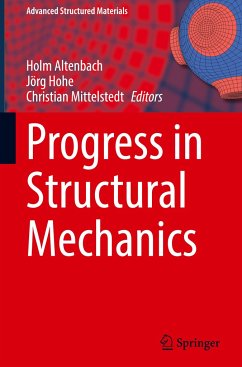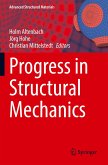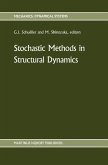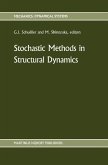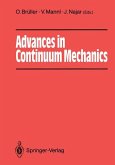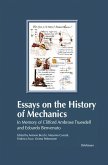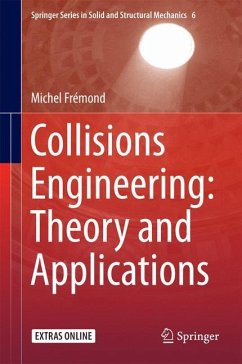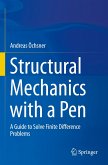Progress in Structural Mechanics
Herausgegeben:Altenbach, Holm; Hohe, Jörg; Mittelstedt, Christian
Progress in Structural Mechanics
Herausgegeben:Altenbach, Holm; Hohe, Jörg; Mittelstedt, Christian
- Gebundenes Buch
- Merkliste
- Auf die Merkliste
- Bewerten Bewerten
- Teilen
- Produkt teilen
- Produkterinnerung
- Produkterinnerung
The book is devoted to the retirement of Prof. Wilfried Becker-a liber amicorum for a well-known specialist in the field of structural mechanics. Many excellent scientists from institutions around the world wrote their scientific chapters, stressing the Becker's influence to structural mechanics. Thus, this collection discusses a lot of important problems and applications of mechanics.
Andere Kunden interessierten sich auch für
![Progress in Structural Mechanics Progress in Structural Mechanics]() Progress in Structural Mechanics116,99 €
Progress in Structural Mechanics116,99 €![Stochastic Methods in Structural Dynamics Stochastic Methods in Structural Dynamics]() Stochastic Methods in Structural Dynamics121,99 €
Stochastic Methods in Structural Dynamics121,99 €![Stochastic Methods in Structural Dynamics Stochastic Methods in Structural Dynamics]() G.I. Schu‰ller / M. Shinozuka (Hgg.)Stochastic Methods in Structural Dynamics121,99 €
G.I. Schu‰ller / M. Shinozuka (Hgg.)Stochastic Methods in Structural Dynamics121,99 €![Advances in Continuum Mechanics Advances in Continuum Mechanics]() Advances in Continuum Mechanics81,99 €
Advances in Continuum Mechanics81,99 €![Essays on the History of Mechanics Essays on the History of Mechanics]() Antonio Becchi / Massimo Corradi / Federico Foce / Orietta Pedemonte (eds.)Essays on the History of Mechanics41,99 €
Antonio Becchi / Massimo Corradi / Federico Foce / Orietta Pedemonte (eds.)Essays on the History of Mechanics41,99 €![Collisions Engineering: Theory and Applications Collisions Engineering: Theory and Applications]() Michel FrémondCollisions Engineering: Theory and Applications77,99 €
Michel FrémondCollisions Engineering: Theory and Applications77,99 €![Structural Mechanics with a Pen Structural Mechanics with a Pen]() Andreas ÖchsnerStructural Mechanics with a Pen53,49 €
Andreas ÖchsnerStructural Mechanics with a Pen53,49 €-
-
-
The book is devoted to the retirement of Prof. Wilfried Becker-a liber amicorum for a well-known specialist in the field of structural mechanics. Many excellent scientists from institutions around the world wrote their scientific chapters, stressing the Becker's influence to structural mechanics. Thus, this collection discusses a lot of important problems and applications of mechanics.
Produktdetails
- Produktdetails
- Advanced Structured Materials 199
- Verlag: Springer / Springer International Publishing / Springer, Berlin
- Artikelnr. des Verlages: 978-3-031-45553-7
- 1st edition 2024
- Seitenzahl: 324
- Erscheinungstermin: 2. Januar 2024
- Englisch
- Abmessung: 241mm x 160mm x 22mm
- Gewicht: 711g
- ISBN-13: 9783031455537
- ISBN-10: 3031455533
- Artikelnr.: 68790282
- Herstellerkennzeichnung Die Herstellerinformationen sind derzeit nicht verfügbar.
- Advanced Structured Materials 199
- Verlag: Springer / Springer International Publishing / Springer, Berlin
- Artikelnr. des Verlages: 978-3-031-45553-7
- 1st edition 2024
- Seitenzahl: 324
- Erscheinungstermin: 2. Januar 2024
- Englisch
- Abmessung: 241mm x 160mm x 22mm
- Gewicht: 711g
- ISBN-13: 9783031455537
- ISBN-10: 3031455533
- Artikelnr.: 68790282
- Herstellerkennzeichnung Die Herstellerinformationen sind derzeit nicht verfügbar.
Holm Altenbach is a member of the International Research Center on Mathematics and Mechanics of Complex Systems (M&MoCS), Italy, and International Association of Applied Mathematics and Mechanics (GAMM). In 1996, he was appointed as a full professor (Engineering Mechanics) at the Martin Luther University Halle-Wittenberg, and since 2011, he has been a full professor at the Otto von Guericke University Magdeburg. He graduated from Leningrad Polytechnic Institute in 1980 (diploma with a distinction), defended his Ph.D. and obtained his postgraduate degree (habilitation) from the same university in 1983 and 1987, respectively. His areas of scientific interest are theory of plates and shells with applications, continuum mechanics and material modeling, generalized media, sandwiches and laminates. He is an Editor-in-Chief of the Journal of Applied Mathematics and Mechanics/Zeitschrift für Angewandte Mathematik und Mechanik (the oldest journal in mechanics in Germany) and of Springer's Advanced Structured Materials series. He is a member of the editorial board of several journals: among them Continuum Mechanics and Thermodynamics, Technische Mechanik, Mechanics of Composite Materials, and Journal of Strain Analysis for Engineering Design. He was awarded the Polish Humboldt Prize in 2018. In November 2019, he was elected as a Foreign Member of the Russian Academy of Sciences and in May 2021 as a Foreign Member of the National Academy of Sciences of Ukraine. Since October 1st, 2022, he is retired. Jörg Hohe is head of the Composite Materials Group of Fraunhofer Institute for Mechanics of materials IWM at Freiburg, Germany. He graduated in from Darmstadt University of Technology with a Diploma degree in mechanics in 1992 and obtained a doctoral degree with a thesis in fracture mechanics in the same department in 1996. After a time in industry as an engineer in technical supervision and inspection, he joined Siegen University at Siegen, Germany as a postdoctoral fellow from 1998 to 2002, interrupted by a research stay as a visiting scholar at Virginia Polytechnic Institute and State University (VirginiaTech) at Blacksburg, VA, USA in 2001. He obtained a habilitation degree from Siegen University in 2003. In 2002 he joined Fraunhofer IWM as a staff scientist and was appointed head of IWM's Composite Materials Group in 2012. Since his habilitation he also is external lecturer (Privatdozent) in the Department of Mechanical Engineering at Siegen University. His research activities include mechanical characterization and numerical modelling of composite materials of all types, especially multiscale simulation and homogenization, continuum mechanics and material modelling, probabilistic methods for uncertainty prediction as well as methods for characterization and prediction of aging and degradation effects. Christian Mittelstedt studied civil engineering at the University of Wuppertal, where he graduatedas Dipl.-Ing. in 1999. He received his doctoral degree from the University of Siegen in 2005 with a dissertation on stress concentration problems in composite laminates. From 2006 he worked in the German aerospace industry as a research engineer and from 2011 as a technical leader and expert in the field of structural analysis. He habilitated in 2012 with a thesis on the stability of thin-walled fibre composite components in lightweight construction and is the author and co-author of more than 200 scientific papers published in international journals, conference proceedings, but also officially recognised calculation manuals. Since August 2016, he has been head of the institute of Lightweight Engineering and Structural Mechanics at the Department of Mechanical Engineering at Darmstadt University of Technology.
1. Numerical and Experimental Analysis of Elastic Three-layer Plate Under Static and Low Velocity Impact Loading.- 2. Reviewing Yield Criteria in Plasticity Theory.- 3. Minimum Test Effort-Based Derivation of Constant-Fatigue-Life Curves - Displayed for the Brittle UD Composite Materials.- 4. Experimental Evaluation and Phase-Field Model of Fracture Behavior of Alumina-Aluminium Graded Composite.- 5. On the Potential of Machine Learning Assisted Tomography for Rapid Assessment of FRP Materials with Defects.- 6. On the Semi-Analytical Modelling of the Free-Edge Stress Field in Cross-Ply Laminated Shells Under Mechanical Loads.- 7. Experimental Quantification of Barrier Effects for Microstructural Short Fatigue Crack Propagation in Martensitic Steel.- 8. On the Difficulty to Implement the Coupled Criterion to Predict Failure in Tempered Glass.- 9. Extended Reduced Bending Stiffness Method for Shear Deformable Laminated Plates.- 10. How Mechanically Inspired Design Rules Help in the Topology Optimization of Structures with Highly Nonlinear Behavior.- 11. Phase Field Modeling of Cracks in Ice.
1. Numerical and Experimental Analysis of Elastic Three-layer Plate Under Static and Low Velocity Impact Loading.- 2. Reviewing Yield Criteria in Plasticity Theory.- 3. Minimum Test Effort-Based Derivation of Constant-Fatigue-Life Curves - Displayed for the Brittle UD Composite Materials.- 4. Experimental Evaluation and Phase-Field Model of Fracture Behavior of Alumina-Aluminium Graded Composite.- 5. On the Potential of Machine Learning Assisted Tomography for Rapid Assessment of FRP Materials with Defects.- 6. On the Semi-Analytical Modelling of the Free-Edge Stress Field in Cross-Ply Laminated Shells Under Mechanical Loads.- 7. Experimental Quantification of Barrier Effects for Microstructural Short Fatigue Crack Propagation in Martensitic Steel.- 8. On the Difficulty to Implement the Coupled Criterion to Predict Failure in Tempered Glass.- 9. Extended Reduced Bending Stiffness Method for Shear Deformable Laminated Plates.- 10. How Mechanically Inspired Design Rules Help in the Topology Optimization of Structures with Highly Nonlinear Behavior.- 11. Phase Field Modeling of Cracks in Ice.

